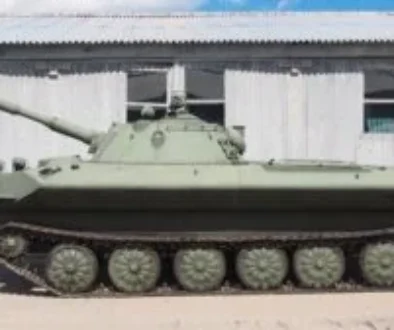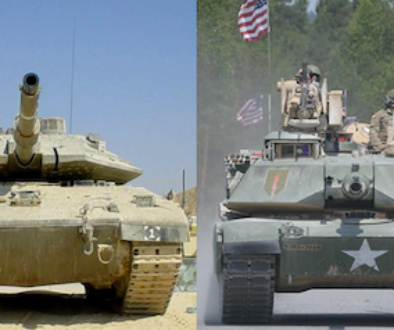Rounding
Up the
Booby Traps
From the
Intelligence Bulletin February 1945
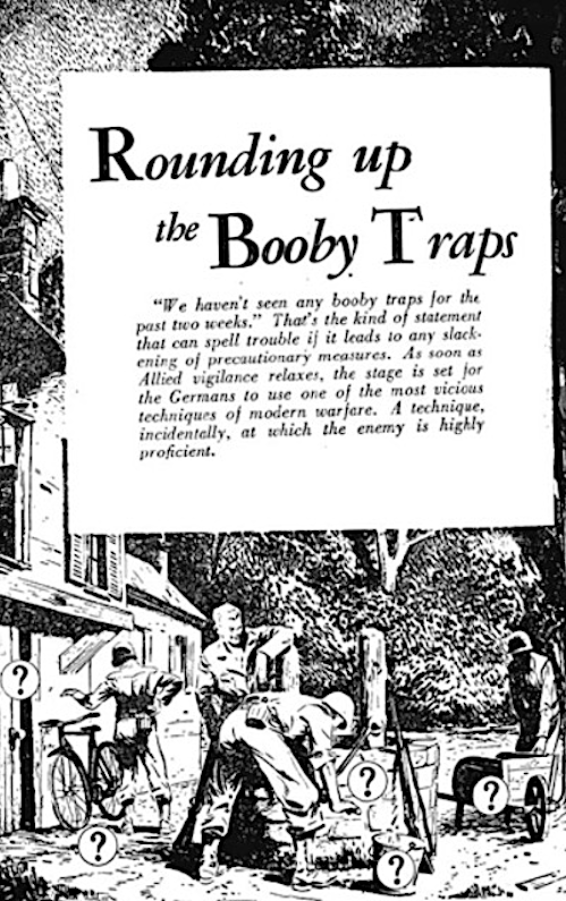
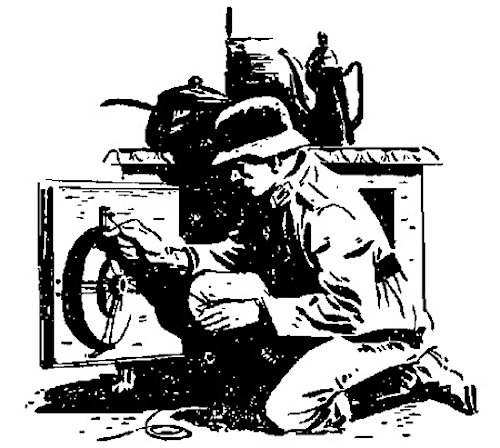
3. Corpses.—Egg grenades have been placed in the pockets of enemy dead. The actuating cords of the grenades are tied to strings, and the strings, in turn are tied to inconspicuous pickets driven into the ground nearby. When the corpse is moved, the grenade explodes.

4. Fruit Trees.—Fruit trees have been fitted with wires leading to pull-igniters and charges of high explosive. When Allied soldiers reach for the lower branches or try to climb the tree, the charges are detonated. 5. Hedges.—The following instance of booby-trapping a hedge at a point where Allied soldiers would be likely to work their way through is typical of many others. Three picric blocks with Z.Z. 35 pull-igniters inserted in them were covered with stones, and were connected with wires to a nearby hedge.
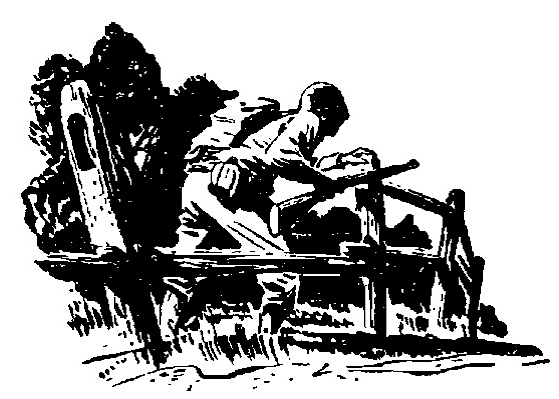
7. River Banks.—-The banks on either side of a river ford, usable only at certain times of the year, were booby-trapped in the following manner. Three 3-kilogram charges (Geballte Ladung) were laid side by side in each bank, with two Z.Z. 42 pull-igniters screwed vertically into the outer charges. Ten-foot length of trip wire led from the igniters and were secured to wooden stakes. Anyone attempting to use the banks would have been likely to trip the wires.
8. Roads.—The Germans have tied grenades to trees on each side of narrow roads, and have strung trip wires across the roads so that the fish-pole aerials or other parts of vehicles-will trip the wires.
9. Telephone Lines.—An enemy patrol came across an artillery observation-post line and cut it. In the immediate vicinity, they buried two S-mines, about 10 yards apart, so that the prongs of the igniters were about 1 inch above the ground level. Each loose end of the telephone wire was attached to a piece of fine cord about 12 inches long, and each cord led to a mine. The result Avas that, in the dark, a linesman picked up what he thought was merely a loose end of wire, and an S-mine exploded. (As the Intelligence Bulletin has previously reported, this ruse has also been employed by the Japanese.) The potential danger of such booby traps is of course considerably less in the daytime.
10. Rubbish Heaps.—The usual booby trap in a rubbish heap consists of an attention-catching object of some value as a souvenir, which is connected to a pull-igniter and a charge or antipersonnel mine by means of a wire or cord.
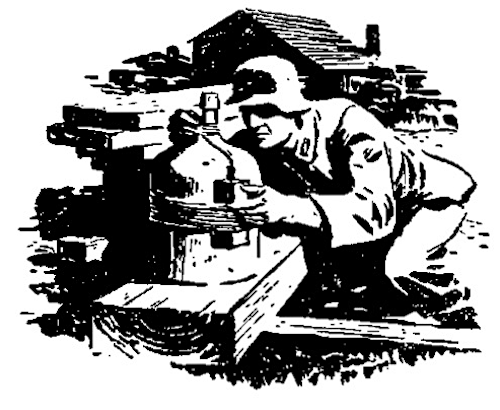
11. Molotov Cocktails as Traps.— Molotov cocktails may be used as booby traps when the Germans believe that particularly successful damage can be caused by fire. Just such a trap was found in a lumber yard. A small explosive charge of cordite with a detonator and primer had been attached to a large bottle of gasoline, which, in turn, had been lashed to a board.
1. Inverted Tellermines.—The Germans often inverted a Tellermine and inserted a D.Z. 35 push-igniter in the bottom hole to make the device antipersonnel in effect.
2. Mines under Planks.—A combination of S-mines and Tellermines may be buried in a road trail, and covered with a plank. Thus pressure caused either by a vehicle or by personnel would lead to detonation
1. Delay Igniters.—Thirty-second delay igniters have been reported fixed to mines, presumably directed against personnel who may attempt to lift such mines by using a cable.
2. Dummy Trip Wires.—Recently a new type of antilifting device has appeared—one which could be used with almost any type of mine, and particularly with wooden mines. Such a device, used in conjunction with an Italian four-igniter mine, employed a stake driven into the ground about 3 feet from the mine, which had been buried about Vfa feet below ground level. A dummy trip wire connected the top of the mine with the stake, while another wire led from a pull-igniter in the bottom of the mine to the bottom of the stake. If the latter wire had been disturbed, it of course would have produced detonation.
3. Devices on S-mines.—A wire may connect an S-mine with a standard 1-kilogram charge. One end of the wire is wound around the base of the mine’s S. Mi.Z. 35 igniter, while the other end is attached to a Z.Z. 35 pull-igniter screwed into the 1-kilogram charge. Also worth mentioning is an instance in which a wooden stake about 12 inches long was driven into the ground, with its top about 2 inches below the surface. A standard 200-gram charge (Sprengkorper 28) was wired to the stake, and a Z.Z. 35 pull-igniter screwed into the charge. An S-mine with a wire string attached, then was placed in a prepared hole, and the other end of the wire was connected to the Z.Z. 35 igniter. The igniter safety pin was withdrawn, and the S-mine itself was armed. As a result, detonation would be caused by anyone lifting the mine carelessly and rapidly, without having disconnected the wire sl-inp;. In addition, the S-mine itself remained a threat to unwary foot-sloggers.
4. Pressure-release Antilifting Device.—A mine may be laid on the pressure-lifting device E.Z. 44 (Entlastungzunder 44), which is subsequently armed and packed around with earth. Lifting the mine allows a rod, which has been kept down by the weight of the mine, to rite and release a striker in the E.Z. 44. This sets off the charge in the igniter and detonates the mine.
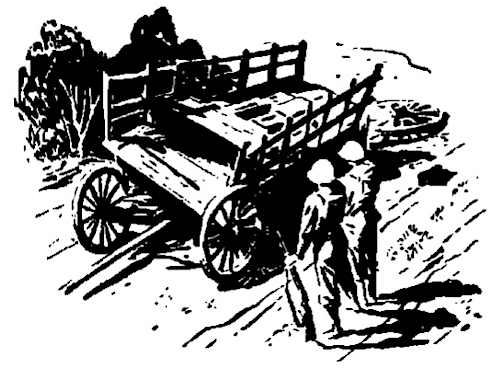
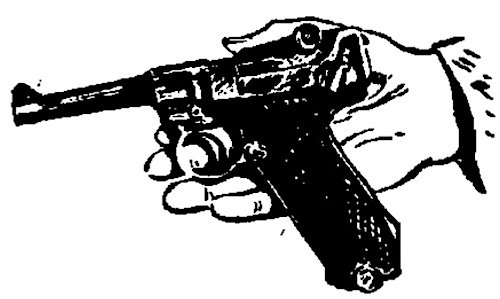
3. Charges Concealed in Weapons.— The Germans sometimes conceal a small charge in the mechanism of a rifle or Luger pistol that they plan to leave behind in a farly obvious place, to attract the attention of Allied soldiers. The charge, which is sufficiently powerful to injure a man severely, is detonated if the trigger of the weapon is pressed.


